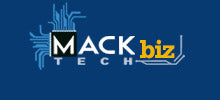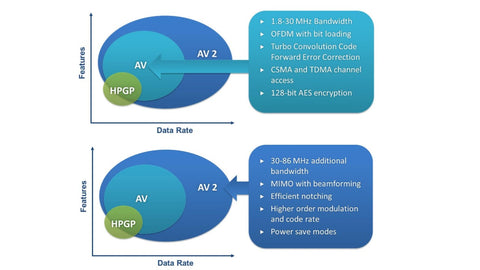
Jun 2023
0 Comments
MackTech Biz
Powerline Ethernet: Revolutionizing Home Networking with Advanced HomePlug AV2 Technology
Introduction
In today's digital age, a stable and reliable internet connection has become a necessity for both work and leisure. While traditional wired and wireless networking solutions have their advantages, Powerline Ethernet (PLC) offers a unique alternative that leverages existing electrical infrastructure to provide high-speed internet connectivity. In this article, we will explore the technology behind Powerline Ethernet, including its frequency, modulation techniques, and the advanced HomePlug AV2 technology that has made it a popular choice for home networking.
Understanding Powerline Ethernet
Powerline Ethernet, also known as Powerline Communication (PLC), utilizes the electrical wiring in a building to transmit data signals. By modulating the electrical signals at specific frequencies, PLC enables the simultaneous transmission of power and data, eliminating the need for additional network cables or extensive wireless setups. This technology has gained significant traction as it provides an easy and cost-effective way to extend network connectivity throughout a home or office.
Frequency and Modulation Techniques
PLC operates within the frequency range of the power grid, typically between 2 MHz and 86 MHz. The choice of frequency depends on various factors, including the power grid regulations, noise interference, and the desired data transmission speed. Lower frequencies are suitable for longer-range transmissions, while higher frequencies allow for faster data rates but over shorter distances.
To combat the inherent challenges of transmitting data over power lines, PLC employs advanced modulation techniques. One widely used modulation technique is Orthogonal Frequency Division Multiplexing (OFDM), which divides the available frequency spectrum into multiple subcarriers. Each subcarrier is modulated independently, allowing for robust data transmission even in the presence of noise and interference. OFDM also enables adaptive modulation, where the system dynamically adjusts the modulation scheme based on the channel conditions, optimizing the data transfer rate and reliability.
Advanced HomePlug AV2 Technology
HomePlug AV2 is an advanced standard of Powerline Ethernet technology that offers significant improvements over its predecessors. It incorporates enhancements in both hardware and software to provide higher data rates, improved coverage, and better overall performance.
One of the key features of HomePlug AV2 is its support for MIMO (Multiple Input Multiple Output) technology. MIMO utilizes multiple transmitters and receivers to improve signal quality and increase data throughput. By leveraging multiple paths in the power grid, MIMO-enabled PLC systems can deliver higher speeds and better coverage, even in challenging environments.
Another notable feature of HomePlug AV2 is the integration of beamforming technology. Beamforming is a signal processing technique that focuses the transmitted signals in a specific direction, improving signal strength and reducing interference. This allows for more efficient use of the power line infrastructure, resulting in enhanced performance and a more reliable connection.
HomePlug AV2 also introduces additional advancements in error correction and quality of service (QoS) mechanisms. These features ensure robust and reliable data transmission, minimizing packet loss and ensuring smooth and uninterrupted performance for latency-sensitive applications such as streaming video and online gaming.
Key Industry Standards associated with HomePlug AV2
The advanced standard of Powerline Ethernet technology, are as follows:
-
IEEE P1901.2: IEEE P1901.2 is a standard developed by the Institute of Electrical and Electronics Engineers (IEEE) for powerline networking using the HomePlug AV2 specification. It defines the physical layer (PHY) and medium access control (MAC) layer specifications for high-speed powerline communications, including HomePlug AV2.
-
ITU-T G.hn: While HomePlug AV2 is a proprietary standard, it is based on and interoperable with the ITU-T G.hn (G.9960 and G.9961) international standard. G.hn is a global standard for high-speed powerline, coaxial, and twisted pair communication. HomePlug AV2 devices conforming to the G.hn standard can interoperate with other G.hn compliant devices from different manufacturers.
-
HomePlug Green PHY: HomePlug Green PHY is another industry standard related to HomePlug AV2. It is designed specifically for low-power, low-cost applications such as smart grid, home automation, and energy management systems. HomePlug Green PHY uses HomePlug AV2 as the foundation while providing additional features tailored to energy-efficient and environmentally friendly solutions.
By adhering to these industry standards, HomePlug AV2 devices ensure compatibility and interoperability with other compliant devices, promoting a consistent and reliable powerline networking experience for users across different manufacturers and deployments.
Interoperability of HomePlug AV to HomePlug AV2
HomePlug AV and HomePlug AV2 are designed to be backward compatible, ensuring a certain level of interoperability between the two standards. Here's what you need to know about their interoperability:
-
Backward Compatibility: HomePlug AV2 devices are typically designed to be backward compatible with HomePlug AV devices. This means that you can integrate HomePlug AV2 devices into an existing HomePlug AV network without issues. You can add HomePlug AV2 devices to your network and have them coexist and communicate with HomePlug AV devices.
-
Mixed Network: You can create a mixed network environment where HomePlug AV and HomePlug AV2 devices operate together. In such a setup, HomePlug AV2 devices will still provide the advantages of the AV2 standard, such as higher speeds and improved performance, while maintaining compatibility with HomePlug AV devices.
-
Performance Considerations: When integrating HomePlug AV2 devices into a HomePlug AV network, it's important to understand that the network's overall performance will be limited by the capabilities of the HomePlug AV devices. HomePlug AV2 devices can achieve their full potential when communicating with other AV2 devices, utilizing the advanced features and higher data rates offered by the AV2 standard.
-
Pairing: To ensure interoperability, it's advisable to pair HomePlug AV2 devices with each other whenever possible. Pairing involves establishing a direct connection between AV2 devices, enabling them to communicate at higher AV2 speeds and take advantage of AV2-specific features. However, even if AV2 devices are not directly paired, they can still communicate with HomePlug AV devices in the network.
Note on the additional Frequency Spectrum of HomePlug AV2
It's important to note that while HomePlug AV2 devices are designed to be backward compatible, there may be some limitations or variances in interoperability depending on the specific devices and implementations. It's recommended to consult the manufacturer's documentation and guidelines for compatibility information and best practices when integrating HomePlug AV and HomePlug AV2 devices in a network.
Generally, HomePlug AV2 devices are interoperable with HomePlug AV devices, allowing for the integration of AV2 devices into an existing AV network. While AV2 devices can provide their advanced features and higher speeds in a mixed network environment, their full potential may be limited by the capabilities of the AV devices.
Benefits and Applications
Powerline Ethernet with HomePlug AV2 technology offers several advantages over traditional networking solutions. Firstly, it leverages existing electrical infrastructure, eliminating the need for additional wiring or drilling holes in walls. It provides reliable connectivity across different rooms, floors, or buildings without signal degradation. PLC is particularly useful in older buildings where wireless signals may face interference from thick walls or long distances.
Furthermore, PLC with HomePlug AV2 is a plug-and-play solution, making it incredibly easy to set up and configure. Users can simply connect the Powerline Ethernet adapters to electrical outlets and establish a network connection. This simplicity, combined with its affordability, makes Powerline Ethernet an attractive option for home users, small businesses, and even larger organizations.
Limitations of Powerline Ethernet
While Powerline Ethernet (PLC) technology offers numerous benefits, it is important to be aware of its limitations as well. Here are some common limitations associated with PLC:
- Distance and Signal Attenuation: The performance of PLC can be affected by the distance between the Powerline Ethernet adapters. As the distance increases, the signal strength tends to weaken, leading to a decrease in data transfer rates. Thick walls, electrical noise, and the presence of certain appliances can also contribute to signal attenuation, further reducing the effective range of PLC. It is advisable to consider the electrical layout and wiring conditions of the building when deploying PLC to ensure optimal performance.
- Electrical Noise and Interference: Power lines are susceptible to electrical noise and interference generated by various devices and appliances connected to the electrical system. This noise can degrade the PLC signal quality, resulting in reduced data throughput and potentially affecting the stability of the network connection. While modern PLC systems employ advanced modulation techniques and error correction mechanisms to mitigate interference, the presence of strong electrical noise sources can still impact performance.
- Network Scalability: PLC networks may face limitations when it comes to scalability. While PLC is well-suited for extending network connectivity within a building, expanding the network to larger environments or multiple buildings can be challenging. As the number of Powerline Ethernet adapters increases, network congestion and interference between different devices can occur, leading to a decrease in overall performance. It is important to consider the scalability requirements of your network and plan accordingly.
- Incompatibility with Power Strips and Surge Protectors: Powerline Ethernet signals can be affected by power strips and surge protectors. These devices, designed to protect electrical equipment, can introduce signal degradation or interfere with PLC transmissions. It is recommended to connect Powerline Ethernet adapters directly to wall outlets whenever possible to avoid potential compatibility issues.
- Limited Cross-Phase Communication: In some cases, PLC signals may have difficulty crossing between different electrical phases in a building's power distribution system. This limitation can affect the ability to establish a network connection between devices located on different phases. It is advisable to ensure that devices connected to the Powerline Ethernet adapters are on the same electrical phase for optimal performance.
Conclusion
Powerline Ethernet (PLC) with advanced HomePlug AV2 technology has revolutionized home networking by utilizing electrical wiring for high-speed data transmission. With its frequency range, modulation techniques like OFDM, and advancements such as MIMO and beamforming, PLC offers a robust and secure networking solution. Its ease of use, cost-effectiveness, and reliable performance make it a popular choice for extending network connectivity in homes and offices. As technology continues to evolve, Powerline Ethernet with HomePlug AV2 is expected to play a significant role in bridging the digital divide and meeting the growing demand for seamless internet connectivity.


